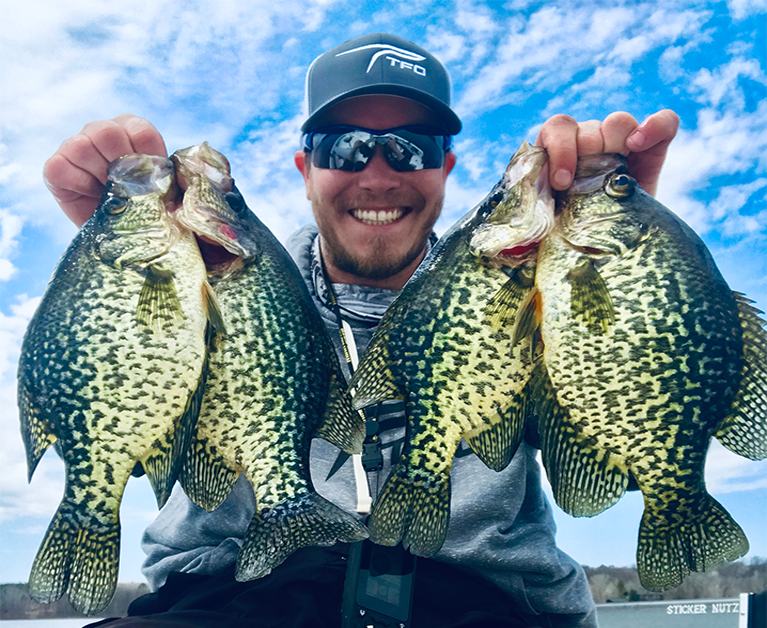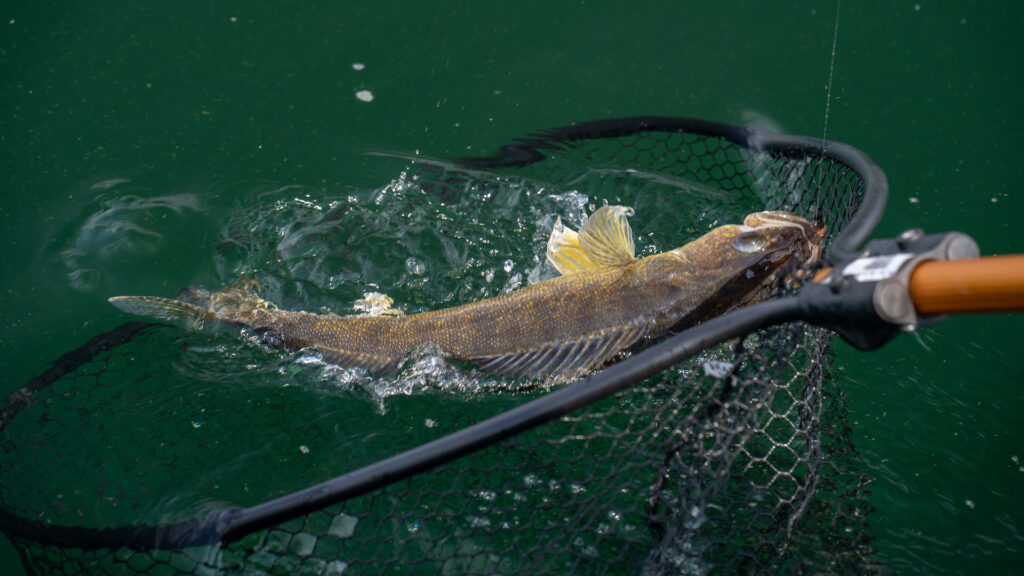As the ice begins to recede on the lakes in the Midwest we start thinking about our first opportunity to dip the boats back in the water. Crappies, who have been wintering in the basin (deep holes) begin to make their migration towards the shallow spawning grounds as the waters start to warm. Crappies are a riot to fish in the springtime and can be caught in a variety of locations, with many different presentations. I’ll be touching base on the How To’s, and the Do’s and Don’ts of Early Spring Crappie fishing. Let’s start at the beginning with Pre Spawn.
Pre Spawn
Crappies are very responsive to water temperature changes which play a crucial role when the first signs of spring come. Shallow water starts to warm into the low to mid 40’s which signals to the crappies they need to increase their foot intake for spawning. The shallow, warmer water is the first to see the start of the new weed growth which attracts the entire food chain, from the invertebrates/bug hatches which bring in smaller fish (minnows) and which are fed on by the crappies, bass, northern etc. As the days start to warm and cool these fish can make their way back and forth from varying depths called a staging area. Staging areas are generally just outside of main spawning grounds (3-12’) and can vary in depth by a few feet.
Temperature swings from early morning to afternoon can rise and lower water temps upwards of 5-6 degrees some days. The sunrise bite might not start in until a little later in the morning when the shallow water starts to warm up a few more degrees. Sunny days can hold true to some of the best crappie fishing. When you put a few of those sunny days together in a row it can sure warm up the water and turn the bite on fast!
Spawn
As the waters temps start to stay consistently around the 55+ degree mark you will start to find crappies getting ready for the spawn. Crappies have a very wide range of temperatures that they have been found spawning in. They have been found dumping eggs at temps upwards of 65 degrees. When the temps finally get into the spawning mark I will slide my search shallower and start in the reeds/cattails from 1-5’. At this time if the water your fishing is clear enough you will actually be able to see fish guarding the beds and can target these fish relatively easy by picking them directly off with a well-placed slip bobber. When these fish end up in the shallows they can be very easy to target in their large numbers. With that being said we as anglers have a duty to keep ourselves in check and think about the conservation as a whole. For me, that means only keeping what I plan to eat and releasing the larger fish to help stimulate healthy genetics for years to come.

Location – Where To Find Them
Crappies will show up in a variety of locations based on different bodies of water, but there are ways to breakdown that water to make it easier for them to be located. Generally, as the sun goes across the sky throughout the day the north sides of the lakes and bays will soak up a majority of the sunlight thus warming up quicker. Bays that are cut off from the main lake can be a great place to start your search as the main lake will have lower temps due to the amount of water that needs to warm up. To help narrow the search down further keep an eye out for bays with old weed growth with a soft/murky bottom. If you can find green cabbage at all there will most likely be fish in the vicinity. New growth starting can also be a key to finding the fish in the back bays. New growth gives off oxygen and attracts numerous other species of life which all get predated on. Crappies are also attracted to areas with bulrushes/cattails, fallen trees, lily pad roots, beaver huts and canals/creeks leading to other lakes. Boat dock areas are great because they are generally shallow and warm quickly. They also contain a lot of structure for them to hide/stalk prey as it goes by. They move around from day to day so each trip out may take some searching to initially find some fish but the rewards can be great!

Tactics & Equipment – How To Fish For Them
Choosing a good rod for the species you’re targeting is always key for fishing. I use a Temple Fork Outfitters 7’ Ultralight Trout/Panfish rod. The length of the rod is great for making long casts which are extremely important when you’re in shallow water as these fish can spook out of an area very easily. One of the best ways to target crappies is from under a float (bobber). I like to use a Northland Tackle Light bite bobber either in the Pencil or Oval. A simple slip bobber is very versatile for being able to pinpoint exactly where you want to place the bait whether its right on the edge of bulrush/pencil weeds or between lily pad roots where they can take cover and ambush prey. Bobbers can be very affective on fish that are either schooled up or spread out on an area. They can be paired with a variety of lures including and not limited to a simple hook/crappie minnow, hair jig, tube jig, plastics, tungsten, or working a fly slowly with a small sinker for a subtle approach. I will either let the bobber soak or slowly retrieve it back to the boat jigging it as I go, but be careful not to over work the bait. One of the easiest ways to search an area for crappies is by using a small jig anywhere from a 1/100th to a 1/16th ounce and tip it with a plastic. I work plastics for a couple different reasons. It keeps the bait on the hook so you know you are not going to lose your bait after a failed hookset and you can cast it farther without having to worry about throwing your bait off.
When searching with your trolling motor it is key to keep a low profile and use creep mode to stealthily invade the shallows (2-10’). Slowly make your way in and if you do end up spooking fish quickly hit your waypoint marker on your electronics and return to that area a little while later after they have returned. Make sure to stay back and take advantage of a long cast. As soon as that first bobber starts going under I hit my spot lock and we post up until we decide our next move.
Jig size, Color, and Presentation can be very critical to catching crappies, and other days it doesn’t matter what you throw at them! My favorite go to colors for jigs are generally white or pink and I like to pair them with my favorite crappie plastics from Juice Bait Co known as the Rubber Chicken. Small tube jigs can work well when other methods are not producing and give the bait a different look in the water. Another way to catch early season crappies is to troll or cast small crankbaits such as the Salmo Hornet at slow speeds giving subtle pulls and pauses to help generate more bites. Trolling can be utilized when the fish are anywhere from 4’+ but is not as feasible in super shallow water. When I troll for crappies I will normally start out a little slower, anywhere from .5mph – .8mph and then slowly increase my speed as I catch fish. When you find your top out speed that they stop biting at back down a couple notches and you can find the sweet spot for how fast they want it!

Photos and Words by Chris Meitzner
Chris is a TFO Pro Staff Ambassador based out of Brainerd, Minnesota. He runs a guiding service called Tight Lines Guide Service. When not targeting crappie, he targets trophy walleye, northern pike and bass in Northern Minnesota. You find out more about Chris here.






